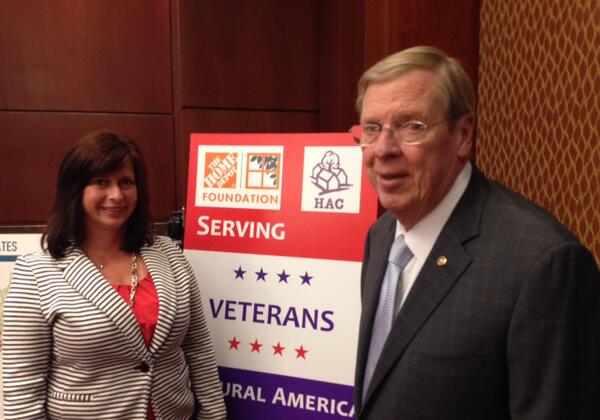On the evening of December 4, 2014, the Housing Assistance Council will present rural housing awards as part of the Rural Housing Awards Banquet at the National Rural Housing Conference. An individual or individuals providing outstanding and enduring service on the national level will be honored with the Cochran/Collings Award for Distinguished Service in Housing for the Rural Poor. A local leader or leaders in rural housing development will receive the Skip Jason Community Service Award.
Award Descriptions
NATIONAL SERVICE AWARD
The Cochran/Collings Award for Distinguished Service in Housing for the Rural Poor honors individuals who have provided outstanding and enduring service, with national impact, for the betterment of housing conditions for the rural poor, with emphasis on the poorest of the poor in the most rural areas.
The award is named after Clay Cochran and Arthur M. Collings, Jr. Dr. Cochran was a mentor and pioneer in the rural housing movement whose work in low-income rural housing dates back to the 1930s and 1940s. Mr. Collings’ dedication to improving housing conditions for low-income rural Americans was unmatched. His feistiness and humor, added to his extensive knowledge of USDA’s rural housing programs, made him unique and well-loved around the country. Dr. Cochran passed away in 1982. Art Collings passed away in March 2010.
Previous winners of this award include Clay Cochran, Obediah Baker, Thomas Carew, Peter Carey, Gordon Cavanaugh, Arthur M. Collings, Jr., Cushing Dolbeare, Eileen Fitzgerald, Elizabeth Herring, Robert Rapoza, Shirley Sherrod, William Simpson, Arnold Sternberg, and four members of Congress: Eva Clayton, Rubén Hinojosa, Stan Lundine, Bennie Thompson and Ed Pastor.
Criteria for Competition
Significant achievements and/or contributions in any or all of the following areas:
- Leadership in national housing organizations;
- Substantial impact on national housing legislation;
- Improving or maintaining funding for rural housing programs that serve the poor, particularly the poorest of the poor;
- Development of new housing programs, preservation of housing programs, or special adaptations to existing programs, which enhance service to the rural poor;
- Improving advocacy and/or enhancing coalition building that leads to improved rural housing opportunities
- Overall enduring service with a national impact towards improving conditions of the ill-housed rural poor, particularly the poorest of the poor.
COMMUNITY SERVICE AWARD
The Skip Jason Community Service Award recognizes people whose efforts have improved the housing conditions of the rural poor in their communities. The award acknowledges people who work “in the trenches” and usually go unrecognized outside their communities.
The award is named after Robert “Skip” Jason, a long-time housing activist with considerable community experience, who died in 1982 while employed as HAC’s Government Services Director.
Prior recipients of this award include David Arizmendi, Clanton Beamon, Lorna Bourg, Guillermo Castaneda, Emma Clifford, John P. David, Paul Douglas, Cora Esquibel, Rose Garcia, Owyne Gardner, Manuel Gauna, Alfred Gold, Arturo C. Gonzales, Patty Griffiths, Dana M. Jones, Stan Keasling, Lewis Kellom, Steve Kirk, Barbara Lamphere, Jerome Little, Sabino Lopez, Griffin Lotson, Lynn Luallen, Steve Mainster, Selvin McGahee, Rito Medina, Madeline Miller, Polly Nichol, John “Jack” Rivel, Jr., Linda Smith, Ted Smith, Lauretta Brice Stephens, Bessie Swan, Mario Villanueva, Sharon Walden, Jim Wilcox, Dwayne Yost, and John Zippert.
Criteria for Competition
Significant achievements and/or contributions in any or all of the following areas:
- Improving the housing conditions of the rural poor in their communities and protecting and enhancing the rights of the poor in housing;
- Community achievement in community development and/or housing;
- Unrecognized efforts that extend outside recipient’s community;
- Increasing the number of housing units produced or preserving existing affordable housing;
- Producing innovative or difficult housing;
- Advocating for affordable housing;
- Any other specific and significant community contribution in the field of low-income rural housing.
~For information, contact Lilla Sutton, HAC, 202-842-8600, lilla@ruralhome.org.

 Rural America has a strong history of protecting our country. In fact, as highlighted in
Rural America has a strong history of protecting our country. In fact, as highlighted in 

